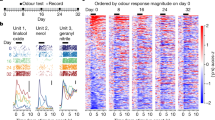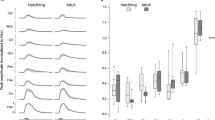Abstract
Neural assemblies in a number of animal species display self-organized, synchronized oscillations in response to sensory stimuli in a variety of brain areas.1,2,3,4,5. In the olfactory system of insects, odour-evoked oscillatory synchronization of antennal lobe projection neurons (PNs) is superimposed on slower and stimulus-specific temporal activity patterns. Hence, each odour activates a specific and dynamic projection neuron assembly whose evolution during a stimulus is locked to the oscillation clock6,7. Here we examine, using locusts, the changes in population dynamics of projection-neuron assemblies over repeated odour stimulations, as would occur when an animal first encounters and then repeatedly samples an odour for identification or localization. We find that the responses of these assemblies rapidly decrease in intensity, while they show a marked increase in spike time precision and inter-neuronal oscillatory coherence. Once established, this enhanced precision in the representation endures for several minutes. This change is stimulus-specific, and depends on events within the antennal lobe circuits, independent of olfactory receptor adaptation: it may thus constitute a form of sensory memory. Our results suggest that this progressive change in olfactory network dynamics serves to converge, over repeated odour samplings, on a more precise and readily classifiable odour representation, using relational information contained across neural assemblies.
This is a preview of subscription content, access via your institution
Access options
Subscribe to this journal
Receive 51 print issues and online access
$199.00 per year
only $3.90 per issue
Buy this article
- Purchase on Springer Link
- Instant access to full article PDF
Prices may be subject to local taxes which are calculated during checkout





Similar content being viewed by others
References
Adrian,E. D. Olfactory reactions in the brain of the hedgehog. J. Physiol. (Lond.) 100, 459–473 (1942).
Eckhorn,R. et al. Coherent oscillations: A mechanism of feature linking in the visual system? Biol. Cybern. 60, 121– 130 (1988).
Gray,C. M., Koenig,P., Engel,A. K. & Singer,W. Oscillatory responses in cat visual cortex exhibit inter-columnar synchronization which reflects global stimulus properties. Nature 338, 334–337 (1989).
Gelperin,A. & Tank,D. W. Odour-modulated collective network oscillations of olfactory interneurons in a terrestrial mollusc. Nature 345, 437–440 (1990).
Prechtl,J. C. Visual motion induces synchronous oscillations in turtle visual cortex. Proc. Natl Acad. Sci. USA 91, 12467– 12471 (1994).
Laurent,G., Wehr,M. & Davidowitz, H. Temporal representations of odors in an olfactory network. J. Neurosci. 16, 3837– 3847 (1996).
Wehr,M. & Laurent,G. Odour encoding by temporal sequences of firing in oscillating neural assemblies. Nature 384, 162–166 (1996).
Freeman,W. J. Spatial properties of an EEG event in the olfactory bulb and cortex. Electroencephalogr. Clin. Neurophysiol. 44, 586– 605 (1978).
Gray,C. M. & Skinner,J. E. Centrifugal regulation of neuronal activity in the olfactory bulb of the waking rabbit as revealed by reversible cryogenic blockade. Exp. Brain. Res. 69, 378–386 (1988).
Mellon,D. Physiological characterization of antennular flicking reflexes in the crayfish. J. Comp. Physiol. A 180, 553– 565 (1997).
Murlis,J., Elkington,J. S. & Cardé, R. T. Odor plumes and how insects use them. Annu. Rev. Entomol. 37, 505–532 (1992).
Laurent,G. & Davidowitz,H. Encoding of olfactory information with oscillating neural assemblies. Science 265, 1872–1875 (1994).
Laurent,G. & Naraghi,M. Odorant-induced oscillations in the mushroom bodies of the locust. J. Neurosci. 14 , 2993–3004 (1994).
MacLeod,K. & Laurent,G. Distinct mechanisms for synchronization and temporal patterning of odor-encoding neural assemblies. Science 274, 976–979 (1996).
Weht,M. & Laurent,G. Relationship between afferent and central temporal patterns in the locust olfactory system. J. Neurosci. 19, 381–390 (1999).
Masson,C. & Mustaparta,H. Chemical information processing in the olfactory system of insects. Physiol. Rev. 70 , 199–245 (1990).
Slifer,E. H. & Sekhon,S. S. The dendrites of the thin-walled olfactory pegs of the grasshopper (Orthoptera, Acrididae). J. Morphol. 114, 393–410 (1965).
MacLeod,K., Bäcker,A. & Laurent, G. Who reads temporal information contained across synchronized and oscillatory spike trains? Nature 395, 693–698 (1998).
Stopfer,M., Bhagavan,S., Smith,B. & Laurent,G. Impaired odour discrimination on desynchronization of odour-encoding neural assemblies. Nature 390, 70–74 (1997).
Lawless,H. T. in Tasting and Smelling (eds Beauchamp, G. K. & Bartoshuk, L.) (Academic, San Diego, 1997).
Kay,S. M. Modern Spectral Estimation (Prentice-Hall, Englewood Cliffs, New Jersey, 1988).
Acknowledgements
We thank B. Smith for help with the statistical analysis of the data. This work was supported by an NRSA from the NIDCD (M.S.), and the NIDCD and the Alfred P. Sloan Foundation (G.L.).
Author information
Authors and Affiliations
Corresponding author
Supplementary information
Rights and permissions
About this article
Cite this article
Stopfer, M., Laurent, G. Short-term memory in olfactory network dynamics. Nature 402, 664–668 (1999). https://doi.org/10.1038/45244
Received:
Accepted:
Issue Date:
DOI: https://doi.org/10.1038/45244
This article is cited by
-
Olfactory system structure and function in newly hatched and adult locusts
Scientific Reports (2024)
-
Neural kernels for recursive support vector regression as a model for episodic memory
Biological Cybernetics (2022)
-
Adaptive temporal processing of odor stimuli
Cell and Tissue Research (2021)
-
Evolutionarily conserved anatomical and physiological properties of olfactory pathway through fourth-order neurons in a species of grasshopper (Hieroglyphus banian)
Journal of Comparative Physiology A (2019)
-
Dynamic contrast enhancement and flexible odor codes
Nature Communications (2018)
Comments
By submitting a comment you agree to abide by our Terms and Community Guidelines. If you find something abusive or that does not comply with our terms or guidelines please flag it as inappropriate.



